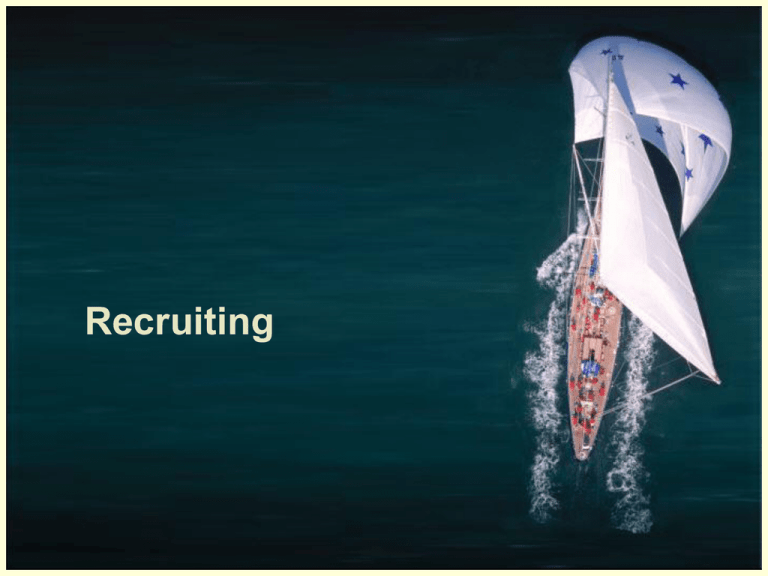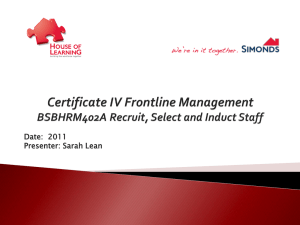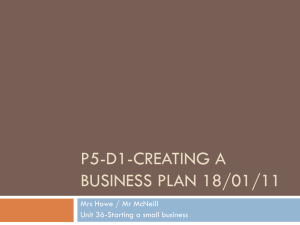
Recruiting
Introduction
Once an organization identifies its human resource
needs through employment planning, it can begin
recruiting candidates for actual or anticipated vacancies.
Recruiting brings together
those with jobs to fill
and
those seeking jobs
Recruiting Goals
recruiting provides information that will attract
a significant pool of qualified candidates and
discourage unqualified ones from applying
recruiters promote the organization to
prospective applicants
Recruiting Goals
Factors that affect recruiting efforts:
organizational size
employment conditions in the area
effectiveness of past recruiting efforts
working conditions, salary, and benefits offered
organizational growth or decline
Recruiting Goals
Constraints on recruiting efforts:
organization’s image
job attractiveness
internal organizational policies
government policy and laws
recruiting costs
Recruiting Sources
internal
searches
employee
referrals
external
searches
The Internet is blazing
trails in recruiting
practices
online and
alternative
Recruiting Sources
internal search
Organizations that promote from within identify
current employees for job openings
by having individuals bid for jobs
by using their HR management system
by utilizing employee referrals
Recruiting Sources
Promoting from Within
Advantages
good public relations
morale building
encouragement of employees and members of protected groups
knowledge of existing employee performance
cost-savings
candidates’ knowledge of the organization
opportunity to develop mid- and top-level managers
Disadvantages
possible inferiority of internal candidates
infighting and morale problems
potential inbreeding
Recruiting Sources
employee
referrals
Current employees can be asked to recommend recruits.
Advantages:
the employee’s motivation to make a good recommendation
the availability of accurate job information for the recruit
employee referrals tend to be more acceptable applicants, more
likely to accept an offer, and have a higher survival rate
Disadvantages:
the possibility of friendship being confused with job performance
the potential for nepotism
the potential for adverse impact
Recruiting Sources
external
searches
Advertisements: Must decide type and location of ad,
depending on job; decide whether to focus on job (job
description) or on applicant (job specification).
Three factors influence the response rate:
identification of the organization
labor market conditions
the degree to which specific requirements are listed.
Blind box ads do not identify the organization.
Recruiting Sources
Employment Agencies:
public or state employment services focus on helping
unemployed individuals with lower skill levels to find jobs
www.careeronestop.org
private employment agencies provide more comprehensive
services and are perceived to offer positions and applicants of a
higher caliber
management consulting firms (“headhunters”) research
candidates for mid- and upper-level executive placement
executive search firms screen potential mid/top-level candidates
while keeping prospective employers anonymous
Recruiting Sources
Schools, colleges, and universities:
may provide entry-level or experienced
workers through their placement services
may also help companies establish
cooperative education assignments and
internships
Recruiting Sources
Job fairs:
attended by company recruiters seeking resumes and
info from qualified candidates
Virtual online job fairs could bring employers and job seekers
together online by logging into a specific Web site at a certain
time. Some sites use avatars as candidates and recruiters.
See:
http://www.inxpo.com/products/virtual-career-fairs/index.htm
http://work.secondlife.com/worksolutions/meetings/
From the WSJ:
http://online.wsj.com/article/SB118229876637841321.html
Recruiting Sources
Professional organizations:
publish rosters of vacancies
run placement services at meetings
control the supply of prospective applicants
labor unions are also in this category
Unsolicited applicants (walk-ins):
may provide a stockpile of prospective applicants if
there are no current openings
Recruiting Sources
online
sources
most companies use the Internet to recruit employees
job seekers use online resumes and create Web pages
about their qualifications
www.nepaljobs.com...
Recruiting Sources
recruiting
alternatives
Temporary help services:
temporary employees help organizations meet short-term fluctuations in
HRM needs
older workers can also provide high-quality help
Employee leasing:
trained workers are employed by a leasing company, which provides
them to employers when needed for a flat fee
typically remain with an organization for longer periods of time
Independent contractors:
do specific work either on or off the company’s premises
costs of regular employees (i.e. taxes and benefits costs) are not
incurred
A Global Perspective
For some positions, the whole world is a relevant
labor market. So, HR can recruit
home-country nationals when searching for someone
with extensive company experience to launch a product
in a country where it has never sold before
host-country nationals when a foreign subsidiary is being
established and HQ wants to retain control yet hire
someone with local market knowledge
candidates of any nationality, creating a truly
international perspective
Your Own Job Search
Job searching takes training, commitment,
endurance, and support. Start searching well before
you plan to start work.
Preparing Your Resume
use quality paper and easy-to-read type
proofread carefully
include volunteer experience
use typical job description phraseology
use a cover letter to highlight your greatest strengths
Use networking to gain access to an organization.
Chapter 7
Foundations of
Selection
The Selection Process
The selection
process typically
consists of eight
steps.
initial screening
Failed to meet minimum qualifications
Passed
completed application
Passed
Failed to complete application or
failed job specifications
employment test
Failed test
Passed
conditional
job offer
Passed
comprehensive interview
Failed to impress interviewer and/or
meet job expectations
background examination
if required
Problems encountered
Passed
permanent
job offer
medical/physical examination
(conditional job offer made)
Able to perform essential
elements of the job
Unfit to do essential
elements of job
reject applicant
The Selection Process
initial screening
interview
Job description information is shared
along with a salary range.
– weeding out of applicants who don’t meet
general job requirements
– screening interviews help candidates decide
if position is suitable
The Selection Process
completing
the application
Gives a job-performance-related synopsis of what
applicants have been doing, their skills and
accomplishments.
Legal considerations
1. omit items that are not job-related; e.g., sex, religion
2. includes statement giving employer the right to
dismiss an employee for falsifying information
3. asks for permission to check work references
4. typically includes “employment-at-will” statement
The Selection Process
completing
the application
Weighted application forms
– individual pieces of information are validated against
performance and turnover measures and given
appropriate weights
– data must be collected for each job to determine how
well a particular item (e.g., years of schooling, tenure
on last job) predicts success on target job
The Selection Process
completing
the application
– information collected on application forms can be
highly predictive of successful job performance
– forms must be validated and continuously
reviewed and updated
– data should be verified through background
investigations
The Selection Process
pre-employment testing
– performance simulation tests require applicants to engage
in job behaviors necessary for doing the job successfully
– work sampling uses job analysis to develop a miniature
replica of the job so the applicant can demonstrate his/her
skills
– assessment centers give tests and exercises, (individual
and group), to assess managerial potential or other complex
skills
Selection practices must be adapted to cultures
and regulations of the host country.
The Selection Process
comprehensive
interviews
– assesses motivation, values, ability to work
under pressure, attitude, ability to fit in
– can be traditional, panel, or situational
– especially useful for high-turnover jobs and less
routine ones
The interview is only as effective as those conducting it.
The Selection Process
comprehensive
interviews
– impression management, (applicant’s desire to
project the “right” image), may skew interview results
– interviewers have short and inaccurate memories:
note-taking and videotaping may help
– behavioral interviews are much more effective at
predicting job performance than traditional interviews
– realistic job previews (brochures, videos, plant tours,
work sampling) help reduce turnover rates
The Selection Process
conditional
job offer
• HR manager makes an offer of employment,
contingent on successful completion of
background check, physical/medical exam, drug
test, etc.
• may use only job-related information to make a
hiring decision
The Selection Process
background
investigation
Verifies information from the application form.
references
former employers
education
legal status to work in U.S.
credit references
criminal records
Online searches can yield too much information on applicants.
See http://www.privacyrights.org/fs/fs16-bck.htm for an analysis of online
background checks as they pertain to employer/employee rights.
The Selection Process
background
investigation
• qualified privilege: employers may discuss
employees with prospective employers without
fear of reprisal as long as the discussion is about
job-related, documented facts
• one-third of all applicants exaggerate their
backgrounds or experiences
• a good predictor of future behavior is an
individual’s past behavior
Companies can be held liable for failure to properly hire.
The Selection Process
medical investigation
• used only to determine if the individual can
comply with essential functions of the job
• Americans with Disabilities Act requires that
exams be given only after conditional job offer is
made
• drug tests can be given at this time
The Selection Process
job offer
• actual hiring decision generally made by the
department manager, not HR manager
• candidates not hired deserve the courtesy of prompt
notification
Resources for Job Seekers: Evaluating Companies
Dun & Bradstreet’s Million Dollar Directory
Standard and Poor’s Register of Corporations
Mergent’s Industrial Review (formerly Moody’s Industrial Manual)
Thomas Register of American Manufacturers
Ward’s Business Directory
From: http://www.bls.gov/oco/oco20046.htm
The Selection Process
The Comprehensive Approach
Comprehensive selection puts applicants
through all the steps in the selection
process before making a decision.
• assesses both strengths and weaknesses,
and is considered more realistic
• must measure factors related to the job only
The Selection Process
Now It’s Up to the Candidate
• most people want jobs compatible with their
personality
• applicants who are not hired this time will still
form an impression about the company
• management should assure the selection
process leaves them with a favorable
impression of the company
Key Elements for
Successful Predictors
What test elements help predict which
applicants will be successful on the job?
reliability
validity
cut scores
Key Elements for
Successful Predictors
reliability
The ability of the selection tool to measure an attribute
consistently.
HR managers need reliable tests to make sure the
applicant will perform satisfactorily
There are companies that specialize in employment testing. For
example, watch the demo at www.eSkill.com
Key Elements for
Successful Predictors
validity
The relationship between scores on a selection tool and a
relevant criterion, such as job performance.
•There are three types:
– content
– construct
– criterion-related
Key Elements for Successful
Predictors
validity
• Content validity: degree to which the content of the test, as a
sample, represents situations on the job
• Construct validity: degree to which a particular (abstract) trait is
related to successful job performance
• Criterion-related validity: degree to which a selection device
accurately predicts important elements of work behavior
– Predictive validity uses test scores of applicants to compare with
their future job performance
– Concurrent validity correlates test scores of current employees
with measures of their job performance
Key Elements for
Successful Predictors
Predictive
Give test to
all
applicants,
record score
and file
Hire based on
criteria other
than test
results
Evaluate
performance
one year
after
beginning
work
Analyze test
scores and
performance
evaluations for
significant
relationship; does
it exist?
Yes
Develop a
battery of
tests
No
Give test
to all
current
employees
Concurrent
Analyze test
scores and
performance
evaluations
for significant
relationship:
does it exist?
No
Yes
Set and
implement
valid cut
scores
Key Elements for
Successful Predictors
cut scores
The cut score separates successful
from unsuccessful performers.
• cut scores on a selection device can be determined by
validity studies
• applicants scoring below the cut score are predicted to be
unsuccessful on the job and are rejected
Selection From a Global
Perspective
• selection criteria for international assignments:
1. interest in working overseas
2. ability to relate to different cultures and
environments
3. supportiveness of the candidate’s family
• female executives have done well abroad in Asia
and Latin America, despite past reluctance to
assign them to these countries
For Further Information
www.expatwomen.com: resources for women taking overseas positions
Best Practices for Managers and Expatriates: A Guide on Selection, Hiring and Compensation
By Stan Lomax: book for managers and overseas assignees
http://www.allbusiness.com/human-resources/858623-1.html analyzes HR models that predict
expatriate success
Excelling at the Interview
Suggestions for making your interviews as an
applicant successful:
1. do some homework on the company
2. get a good night’s rest the night before
3. dress appropriately
4. arrive for the interview a few minutes early
5. use a firm handshake
6. maintain good eye contact
7. take the opportunity to have practice interviews
8. thank the interviewer in person, and send a thank-you note
For the “don’t do’s” see http://hotjobs.yahoo.com/career-articles10_ways_to_be_liked_in_your_job_interview-947
Basic Features of Interviews
• An interview
– A procedure designed to obtain information from a
person through oral responses to oral inquiries
• Types of interviews
– Selection interview
– Appraisal interview
– Exit interview
• Interviews formats
– Structured
– Unstructured
Types of Interviews
• Selection interview
– A selection procedure designed to predict future job
performance on the basis of applicants’ oral
responses to oral inquiries.
• Appraisal interview
– A discussion, following a performance appraisal, in
which supervisor and employee discuss the
employee’s rating and possible remedial actions.
• Exit interview
– An interview to elicit information about the job or
related matters to the employer some insight into
what’s right or wrong about the firm.
Formats of Interviews
• Unstructured or nondirective interview
– An unstructured conversational-style interview
in which the interviewer pursues points of
interest as they come up in response to
questions.
• Structured or directive interview
– An interview following a set sequence of
questions.
Interview Content: Types of
Questions
• Situational interview
– A series of job-related questions that focus on
how the candidate would behave in a given
situation.
• Behavioral interview
– A series of job-related questions that focus on
how they reacted to actual situations in the
past.
• Job-related interview
– A series of job-related questions that focus on
relevant past job-related behaviors.
Interview Content: Types of
Questions
• Stress interview
– An interview in which the interviewer seeks to
make the applicant uncomfortable with
occasionally rude questions that supposedly
to spot sensitive applicants and those with low
or high stress tolerance.
• Puzzle questions
– Recruiters for technical, finance, and other
types of jobs use questions to pose problems
requiring unique (“out-of-the-box”) solutions to
see how candidates think under pressure.
Personal or Individual Interviews
• Unstructured sequential interview
– An interview in which each interviewer forms
an independent opinion after asking different
questions.
• Structured sequential interview
– An interview in which the applicant is
interviewed sequentially by several persons;
each rates the applicant on a standard form.
• Panel interview
– An interview in which a group of interviewers
questions the applicant.
Personal or Individual
Interviews
• Panel (broad) interview
– An interview in which a group of interviewers
questions the applicant.
• Mass interview
– A panel interviews several candidates
simultaneously.
Computerized Interviews
• Computerized selection interview
– An interview in which a job candidate’s oral
and/or computerized replies are obtained in
response to computerized oral, visual, or
written questions and/or situations.
• Characteristics
– Reduces amount of time managers devote to
interviewing unacceptable candidates.
– Applicants are more honest with computers
– Avoids problems of interpersonal interviews
– Mechanical nature of computer-aided
interview can leave an applicant dissatisfied.
Factors Affecting Interviews
• First impressions
– The tendency for interviewers to jump to
conclusions—make snap judgments—about
candidates during the first few minutes of the
interview.
– Negative bias: unfavorable information about
an applicant influences interviewers more
than does positive information.
Factors Affecting Interviews
(cont’d)
• Misunderstanding the job
– Not knowing precisely what the job entails
and what sort of candidate is best suited
causes interviewers to make decisions based
on incorrect stereotypes of what a good
applicant is.
• Candidate-order error
– An error of judgment on the part of the
interviewer due to interviewing one or more
very good or very bad candidates just before
the interview in question.
Factors Affecting Interviews
(cont’d)
• Nonverbal behavior and impression
management
– Interviewers’ inferences of the interviewee’s
personality from the way he or she acts in the
interview have a large impact on the
interviewer’s rating of the interviewee.
– Clever interviewees attempt to manage the
impression they present to persuade
interviewers to view them more favorably.
Factors Affecting Interviews
(cont’d)
• Effect of personal characteristics:
attractiveness, gender, race
– Interviewers tend have a less favorable view
of candidates who are:
• Physically unattractive
• Female
• Of a different racial background
• Disabled
Factors Affecting Interviews
(cont’d)
• Interviewer behaviors affecting interview
outcomes
– Inadvertently telegraphing expected answers.
– Talking so much that applicants have no time
to answer questions.
– Letting the applicant dominate the interview.
– Acting more positively toward a favored (or
similar to the interviewer) applicant.
Designing and Conducting the
Interview
• The structured situational interview
– Use either situational questions (preferred) or
behavioral questions that yield high criteria-related
validities.
– Step 1: Job Analysis
– Step 2: Rate the Job’s Main Duties
– Step 3: Create Interview Questions
– Step 4: Create Benchmark Answers
– Step 5: Appoint the Interview Panel and Conduct
Interviews
How to Conduct an Effective Interview
• Structure your interview:
1. Base questions on actual job duties.
2. Use job knowledge, situational, or behaviorally
oriented questions and objective criteria to evaluate
the interviewee’s responses.
3. Train interviewers.
4. Use the same questions with all candidates.
5. Use descriptive rating scales (excellent, fair, poor)
to rate answers.
6. Use multiple interviewers or panel interviews.
7. If possible, use a standardized interview form.
8. Control the interview.
9. Take brief, unobtrusive notes during the interview.
Examples of Questions That Provide
Structure
Situational Questions:
1. Suppose a co-worker was not following standard work procedures. The co-worker was
more experienced than you and claimed the new procedure was better. Would you use the
new procedure?
2. Suppose you were giving a sales presentation and a difficult technical question arose that
you could not answer. What would you do?
Past Behavior Questions:
3. Based on your past work experience, what is the most significant action you have ever taken
to help out a co-worker?
4. Can you provide an example of a specific instance where you developed a sales
presentation that was highly effective?
Background Questions:
5. What work experiences, training, or other qualifications do you have for working in a
teamwork environment?
6. What experience have you had with direct point-of-purchase sales?
Job Knowledge Questions:
7. What steps would you follow to conduct a brainstorming session with a group of employees
on safety?
8. What factors should you consider when developing a television advertising campaign?
Note: So that direct comparisons can be made, an example is presented to assess
both teamwork (1,3,5,7) and sales attributes (2,4,6,8) for each type of question.
Source: Michael Campion, David Palmer, and James Campion, “A Review of
Structure in the Selection Interview,” Personnel Psychology (1997), p. 668.
Figure 7–3
How to Conduct an Effective
Interview (cont’d)
• Prepare for the interview
– Secure a private room to minimize interruptions.
– Review the candidate’s application and résumé.
– Review the job specifications
• Establish rapport
– Put the person at ease.
• Ask questions
– Follow your list of questions.
– Don’t ask questions that can be answered yes or no.








